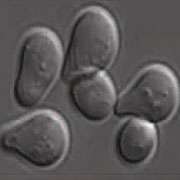You had me at hello: Frisky yeast know who to 'shmoo' after 2 minutes

(PhysOrg.com) -- Yeast cells decide whether to have sex with each other within two minutes of meeting, according to new research published today in Nature. One of the authors of the study, from Imperial College London, says the new insights into how yeast cells decide to mate could be helpful for researchers looking at how cancer cells and stem cells develop.
Yeasts are single-celled microbes that scientists often use as model organisms, to help them understand how cells work. They usually reproduce asexually, by a process called budding, where a part of the cell is pinched off and becomes a new cell, identical to the original.
Sometimes, yeast cells reproduce sexually, by mating. The mating process involves one cell of each sex joining together, then mixing their DNA and splitting apart again. To do this, the cells each have to produce a nodule that they can join together, called a shmoo. The process of shmooing takes around two hours.
In today's new study, researchers from Imperial College London, Université de Montréal, McGill University and the University of Edinburgh determined that a yeast cell's decision to mate is controlled by a chemical change on a single protein. This change occurs two minutes after the cell detects a pheromone produced by the opposite sex, meaning that the decision to mate occurs much more quickly than scientists previously thought.
The researchers also found that in order for the mating process to be switched on, the pheromone must reach a critical concentration in the environment around the yeast cell. Below this concentration, the yeast cell continues to reproduce asexually.
"Shmooing is a very energy-intensive process for yeast cells. We think this switching process at a certain pheromone concentration may have evolved to make sure the cells only get prepared for sexual reproduction if a mate is sufficiently close enough and able to mate," said Dr Vahid Shahrezaei, one of the authors of the study from the Department of Mathematics at Imperial College London.
The researchers used a highly complex mathematical model to determine what switches the mating process on and off, factoring in experimental data about the concentration of pheromones around the cell, the concentrations of different proteins relevant to mating inside the cell and how strongly these proteins bind together.
They believe their mathematical model can potentially be used to investigate the triggers that cause changes in other cells, such as stem cells becoming heart or bone cells, or normal cells becoming cancerous. This is because mammalian cells and yeast cells contain many of the same proteins, which work together in a chain reaction to trigger a decision in the cell. Therefore, today's new model could ultimately help researchers to develop new drugs and therapies.
Dr Shahrezaei said: "Yeast cells live in a very noisy environment - they are surrounded by different chemicals, including pheromones and food, and their own machinery inside the cell produces lots of biomolecules that interact with each other. We wanted to see how cells make sense of this noisy environment and work out what is happening, at a molecular level, to make a important decision like mating.
"By combining experiments and mathematical modelling that take lots of different factors into consideration, we have been able to show exactly what is happening inside a yeast cell to make it decide whether to mate with another cell. We also showed that the mechanism that leads the cells to make their decision is very robust, meaning it is not affected by molecular noise in the environment," added Dr Shahrezaei.
"Although yeast is dramatically different from people, at a molecular and cellular level we have a lot in common," said senior author Dr Stephen Michnick, a Université de Montréal biochemistry professor and Canada Research Chair in Integrative Genomics. "The same molecules that create the switching decision in yeast are found in very similar forms in human cells. Similar switching decisions to those made by yeast are made by stem cells during embryonic development and become dysfunctional in cancers."
More information: "The scaffold protein Ste5 directly controls a switch-like mating decision in yeast " Nature, 18 April 2010. www.nature.com/nature/journal/ … ull/nature08946.html
Provided by Imperial College London

















